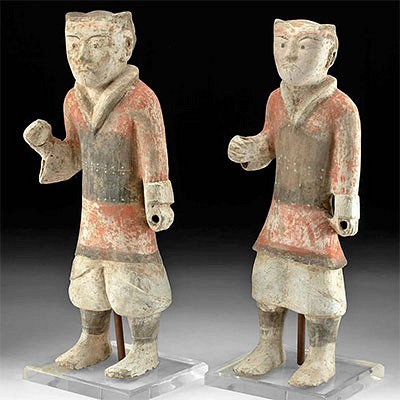Prehistoric Mississippian Caddo Pottery Bowl
Lot 127
About Seller
Artemis Fine Arts
686 S Taylor Ave, Ste 106
Louisville, CO 80027
United States
Selling antiquities, ancient and ethnographic art online since 1993, Artemis Gallery specializes in Classical Antiquities (Egyptian, Greek, Roman, Near Eastern), Asian, Pre-Columbian, African / Tribal / Oceanographic art. Our extensive inventory includes pottery, stone, metal, wood, glass and textil...Read more
Categories
Estimate:
$700 - $1,050
Absentee vs Live bid
Two ways to bid:
- Leave a max absentee bid and the platform will bid on your behalf up to your maximum bid during the live auction.
- Bid live during the auction and your bids will be submitted real-time to the auctioneer.
Bid Increments
| Price | Bid Increment |
|---|---|
| $0 | $25 |
| $300 | $50 |
| $1,000 | $100 |
| $2,000 | $250 |
| $5,000 | $500 |
| $10,000 | $1,000 |
| $20,000 | $2,500 |
| $50,000 | $5,000 |
| $100,000 | $10,000 |
| $200,000 | $20,000 |
About Auction
By Artemis Fine Arts
May 25, 2023
Set Reminder
2023-05-25 10:00:00
2023-05-25 10:00:00
America/New_York
Bidsquare
Bidsquare : ON-SALE! Antiquities, Pre-Columbian, Ethno, Fine Art
https://www.bidsquare.com/auctions/artemis-gallery/on-sale-antiquities-pre-columbian-ethno-fine-art-12860
ON-SALE Antiquities, Pre-Columbian, Ethno, More! Artemis Fine Arts info@artemisfinearts.com
ON-SALE Antiquities, Pre-Columbian, Ethno, More! Artemis Fine Arts info@artemisfinearts.com
- Lot Description
Native American, Southern United States, Arkansas, Arkansas County, Benson site, Mississippian / Caddo culture, ca. 1200 to 1700 CE. A hand-built pottery bowl in a warm beige-brown with an incised shoulder, a repeating program of linear and geometric markings. Caddoan pottery was the finest produced by the Mississippian culture, with very thin walls, intricate motifs, and well-proportioned shapes. These ceramics are largely considered the apex of the art of the Southeast. Size: 7.75" Diameter x 3.75" H (19.7 cm x 9.5 cm)
According to the Sam Noble Museum (Oklahoma's Museum of Natural History), "We will never fully understand the underlying social and spiritual significance of the meanings intertwined within the designs of Caddo pottery. This knowledge was passed down orally and was not recorded by early European explorers, so it has since been partially lost through attempts by the United States government in the 19th and 20th centuries to overwhelm and assimilate the Caddo people. Caddo people began an earlier rapid change after their first contacts with Spanish colonists in the 1500s. Smallpox, measles, cholera and other European diseases ravaged the Caddo and reduced their population by 95 percent before 1700. Archaeological evidence reveals larger villages along the Arkansas, Red, and Ouachita rivers were abandoned and a change from burial of elites only in mounds to community mortuaries during this time period."
Provenance: private Santa Fe, New Mexico USA collection; ex-Michelle Torrez collection, Santa Fe, New Mexico, USA
All items legal to buy/sell under U.S. Statute covering cultural patrimony Code 2600, CHAPTER 14, and are guaranteed to be as described or your money back.
A Certificate of Authenticity will accompany all winning bids.
We ship worldwide and handle all shipping in-house for your convenience.
#178706Chips to rim and hole to basin as shown. Light mineral deposits. Overall great condition.Condition
- Shipping Info
-
All shipping is handled in-house for your convenience. Your invoice from Artemis Gallery will include shipping calculation instructions. If in doubt, please inquire BEFORE bidding for estimated shipping costs for individual items.
-
- Buyer's Premium



 EUR
EUR CAD
CAD AUD
AUD GBP
GBP MXN
MXN HKD
HKD CNY
CNY MYR
MYR SEK
SEK SGD
SGD CHF
CHF THB
THB














